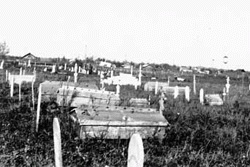|
Unmarked graves are hardly noticeable. To someone walking through the cemetery, they just look like depressions in the ground. That's it. But for John Bagoy, they are important reminders of lost identity. Among those being identified in the unmarked graves are many infants, Bagoy said, as well as people who died during the terrible worldwide flu epidemic of 1919.
Thanks to the untiring efforts of a retired Anchorage man who has teamed up with the Cook Inlet Historical Society, CIRI and other donors, nearly 3,000 unmarked graves in the Anchorage Memorial Park Cemetery have been identified and will be marked. About a third of the graves are those of Alaska Natives, and some date back to the cemetery's earliest beginnings in 1915.
 |
| This view of the Anchorage Memorial Park Cemetery was taken in 1937 from the corner of Eighth Avenue and Cordova Street. Many of the graves shown in the photo are for Athasbascans, and they feature wooden markers and spirit houses. Over time, these wooden markers deteriorated, and these graves became unmarked. Photo courtesy John Bagoy. |
 |
"No matter who they are or what status they had in life, I think every person should leave a legacy, even if it's just a name on a piece of rock," said Bagoy, a 79-year-old retired electrical supply sales representative who was born and raised in Anchorage.
Jim Barnett, president of the Historical Society, said he is pleased to be able to support the efforts of John Bagoy to identify and honor the deceased in the unmarked graves.
"The point is that the society thinks the cemetery is more than a resting place. It's a repository of the early history of our community. It's a history lesson," Barnett said.
The final price tag for the restoration project, which may be completed in the next three or four years, may be as high as $250,000. Barnett noted that the key sponsor of the project is Ed Rasmuson and the National Bank of Alaska. In addition to CIRI and the Historical Society, there are a number of other donors who are contributing, he said.
Barnett said the Municipality of Anchorage also is very supportive and will be responsible for installing the markers, as well as some of the other restoration work on the graves.
Bagoy's parents were florists, and he recalls spending many hours of his childhood assisting his mother in decorating graves. He said as a result, he has a very long-term interest in the cemetery and was always aware of its neglect. Although about 9,500 people are buried in the cemetery, nearly a third of those burials were unmarked.
He began restoration work on the cemetery about 10 years ago on a volunteer basis, and has focused on unmarked graves for the last three years.
Bagoy offers a public tour of the cemetery on Summer Solstice. The tour runs about an hour, and Bagoy offers a running commentary on many of the city's early leaders. CIRI shareholder Ada Blackjack Johnson's grave is among those noted by Bagoy. Johnson was the only survivor of an ill-fated expedition to Wrangel Island in the early 1920s organized by Arctic explorer Vilhjalmur Stefansson.
Bagoy said about 600 markers were installed on unmarked graves in 2001. Each granite marker is about 12 inches by 12 inches and about 3 inches thick. Colors include cinnamon, Georgia grey, black, blue, pearl and rose. Each marker will include the deceased's name, as well as the date of birth and date of death.
Researching records for the deceased has been a major – and very time-consuming – effort. Records were haphazard, and in many cases Bagoy had to find the names among hundreds of pieces of paper – some just scraps. Besides the personal satisfaction Bagoy gets from knowing he has found a way to honor the dead, he said hundreds of people from all over the United States have contacted him to thank him for his efforts.
Bagoy also has other plans for cemetery restoration work. Eventually he hopes to get spirit houses installed on the graves of three Athabascan chiefs buried in the cemetery, and possibly Orthodox crosses.
"When I look at this work, to me it's very gratifying," Bagoy said. "A city is judged by what its cemetery looks like."
And someday, Bagoy himself plans to be buried in the cemetery. "I have a reservation there, next to my parents."
|




